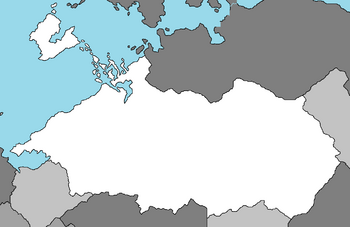Rumaztria
Kingdom of Rumaztria | |
|---|---|
|
Flag | |
| Motto: In Varietate Unitas! | |
| Anthem: God Save the King | |
 | |
| Capital | Karlsberg |
| Official languages | English, Rumaztri |
| Recognised national languages | French, German |
| Recognised regional languages | Spanish, Mandarin |
| Demonym(s) | Rumaztrian |
| Government | Absolute Monarchy |
• King | Caslav VI |
| Lord Andersen | |
| Area | |
• | 2,934,017 km2 (1,132,830 sq mi) |
• Water (%) | 7.3 |
| Population | |
• 2020 estimate | 115,420,650 |
• 2012 census | 105, 820,095 |
• Density | 39.34/km2 (101.9/sq mi) |
| GDP (nominal) | 2020 estimate |
• Total | 12.958 Trillion |
• Per capita | 57,329 |
| Gini (2016) | 0.451 low |
| HDI (2019) | 0.89 very high |
| Currency | Quetzal (RQT) |
| Time zone | RNT |
| Date format | dd-mm-yyyy |
| Driving side | left |
| Calling code | +311 |
The Kingdom of Rumaztria, most commonly known as Rumaztria, is a nation on Iearth, located on the continent of Ausiana and bordered by Vulkaria, Kiergat, Karnaim, Archimenistan, Arakinistan, and Barangadesh. Rumaztria also shares maritime borders with Styrae and Jefferson. It is a member state of the Coalition of Crown Albatross, having joined on March 7th 1986 after 32 years of isolation from global politics following the World War (Iearth).
With its five provinces and Imperial Capital territory containing a population of just under 90 million residents, it is considered a secondary economic ,social and political powerhouse, lagging behind the great four powers of the Council of Crown Albatross. The capital of Karlsberg is the largest city in the nation with a population of just below 7 million residents within the city's limits and a total of 12.5 million residents within its metropolitan area. The next four largest cities in the nation in order of population are Colteaux, Eskiftanes, Aarstieg and Holtastaoir. The population is mostly situated on the coast although the size of the inland population has exponentially grown over the last 20 years as a result of a government initiative to populate the sparsely populated interior as well as decongesting the coastal cities, allowing the cities of Eskiftanes and Holtastaoir to grow into the bustling cities that they are today. The Rumaztrian population is highly urbanized, with over 70 percent of its inhabitants concentrated in urban centres.
The Rumaztrian Economy has traditionally relied on its valuable deposits of iron, phosphate rocks, bauxite, diamonds, and fish as well as agricultural produce such as wheat, barley, cotton, sugarcane and corn. During the second Industrial revolution however, the nation quickly rose as an industrial powerhouse in Ausiana thanks to its abundant resources. An emerging issue soon emerged, that of Rumaztria's small population as compared to other nations such as Zamastan and Gladysynthia. A series of conquests soon followed in the early 20th century, adding a significant portion of land as well as millions of new inhabitants resulting in rapid and massive industrial expansion. Rumaztria's rapid growth would soon come crashing down as a result of the World War, of which its aftermath would affect the nation for years. The nation, immediately following the conclusion of the war, adopted a policy of isolation from global politics until the 1985 Eskiftanes Stock Market Collapse which brought Rumaztria's economy to its knees. King Gustav III, forced by the dire economic position, reached out to the Zamastanians, leading to the signing of the 1986 Tofino Agreement officially securing Rumaztria's return to global politics. The nation soon joined the Coalition of Crown Albatross and the General Assembly, allowing it to receive much needed foreign grants and loans to reinvigorate its ailing economy.
The modern day Kingdom is considered a secondary power, having grown exponentially in the last thirty years. Rumaztria maintains a strong military, having participated in several conflicts as a part of the CCA's peacekeeping force, as well as diplomatic relations with most nations on Iearth. The Kingdom still harbors animosity towards its northern neighbor, Vulkaria, due to past historical events. The nation however maintains its stance as a peaceful nation, although time will tell of its course in modern day geopolitics.
Etymology
While many theories surmise as to the etymological origins of Rumaztria, the name is nowadays accepted as having originated from the Huvrenska Tribe, the founders of the Ira'xqi Chiefdom, later to be the Huvrenska State. The name is derived from the Huvrenska words Rma'z meaning Angels and Tr'ae meaning land or territory. The name slowly developed over the centuries until 1639, when the Kingdom of Rumaztria was proclaimed, officially adopting its modern name.
The standard way to refer to a person from Rumaztria is as a Rumaztrian, although Rumaztri is acceptable and used interchangeably

